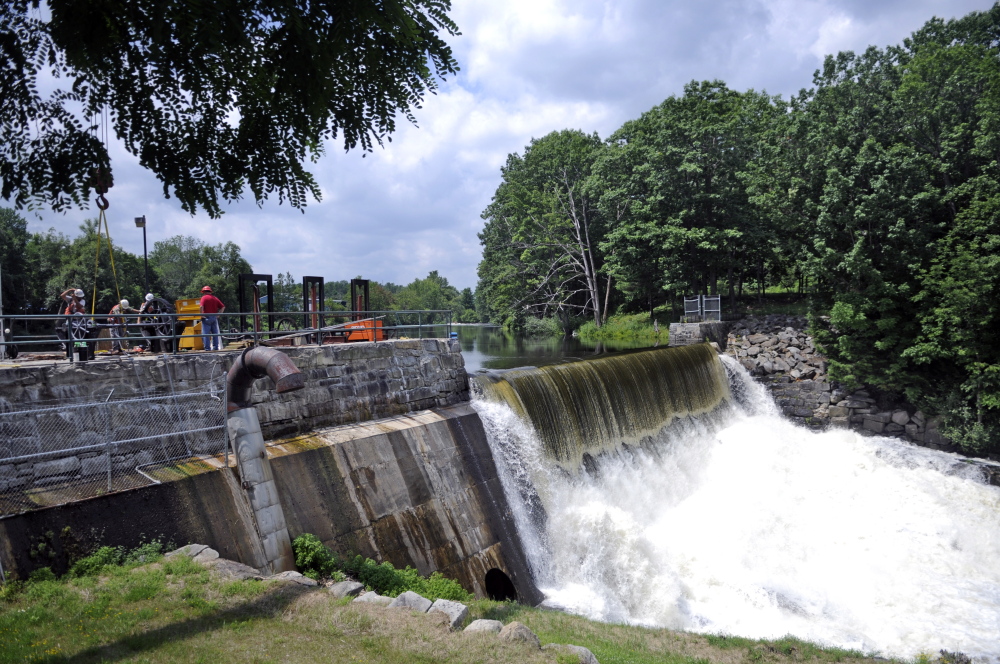GARDINER — Two long-standing goals — to build a walkway along Cobbossee Stream and to revitalize blighted, aging industrial buildings in the area — are getting a renewed focus from the city with a series of workshops aimed at collecting public input and drumming up support for the projects.
The city hopes to leverage U.S. Department of Environmental Protection grants awarded last year and recent economic development efforts to spur community interest in redeveloping the areas along Cobbossee Stream and to come up with new ideas for potential projects.
The first of four public meetings and workshops is scheduled for 6 p.m. Thursday in the Gardiner Area High School theater.
While other parts of the Cobbossee Watershed in Manchester and Winthrop are seen as attractive, the Gardiner region hasn’t seen the same interest in development, said Nate Rudy, director of economic and community development for the city.
“Our Cobbossee seems to have a stigma associated with it, and right now people have their backs turned,” he said.
The city, along with surrounding communities, owes its existence to the first mills built along the stream. The stream’s powerful current, dropping 127 feet in elevation in just over a mile and emptying into the Kennebec River, attracted lumber and grist mills in the 18th century and paper mills and manufacturers later; but now some of those former industrial buildings look neglected and forgotten. There’s some commercial use in buildings along the stream, but some envision more modern uses in the future.
The so-called Cobbossse Corridor, the area around the stream from New Mills Dam to the Kennebec River, was the subject of a lengthy plan adopted by the city in 2005 that called for commercial, residential and mixed-use development and recreational options, such as the walking trail. Both building a trail along the stream and redeveloping the Summer Street area near the stream were long-range goals in a 1999 downtown revitalization plan by the city — although that plan projected the work be completed between 2005 and 2008.
The newest effort will involve University of Maine at Augusta architecture students who will help design ideas for the area. Thursday’s meeting will include an overview of the process, the history of past efforts and the Cobbossee Corridor Master Plan adopted in 2005, Rudy said. The other meetings are scheduled for July 24 at the Boys and Girls Club of Greater Gardiner, Aug. 7 at Johnson Hall Performing Arts Center and Aug. 21 at City Hall.
The DEP awarded two three-year grants worth $400,000 to the city last year to evaluate the properties in the area for possible contaminants. Businesses and property owners can use the federal brownfields program to see if there are contaminants such as oil in the ground around their properties.
Additional funding may be available to help in cleaning up any contaminants that are found, Rudy said. So far, only the ground behind Johnson Hall on Mechanic Street has been tested. He said part of the purpose of the testing is to show that properties are clean in some cases.
“What I hope is we find no contamination in any of these buildings, but by doing the studies we will lift any stigma people may associate with the buildings,” Rudy said.
Some of the most noteworthy properties that Rudy sees as having a potential for redevelopment are the T.W. Dick Steel Co. properties on Summer Street, which include a 12,000-square-foot metal shop and its main office building, on the corner of Bridge Street.
The company’s owner, Eric Vogel, said it’s still an active business, but he would sell the buildings if the right deal came along. Until then, he said, he thinks doing the brownfields assessment would be a waste of time. He said the city is beating a dead horse by trying to develop the Cobbossee Corridor again.
“Until they show up to my doorstep waving a checkbook, it’s all B.S.,” Vogel said in a phone interview.
Brian Kent, an architect from Litchfield who wrote the original plan for the corridor, said he thinks the potential for mixed-use development outlined in the plan are still there. He said contaminant assessments will help show the potential and the possible problems facing property owners in the area.
“It’s just going to take vision and hard work,” Kent said in a phone interview.
The city developed an initial design and engineering plan in 2009 with a grant from the Maine Department of Transportation for the pedestrian and bicycle trail along the stream, which would connect with the Kennebec River Rail Trail in the Hannaford supermarket parking lot off Maine Avenue. The city has been approved for a grant from the department to fund the project, but it first must come up with a 20 percent match.
It’s unlikely the estimated $200,000 needed from the city will be approved by the City Council anytime soon, Rudy said, so some type of fundraising effort will be needed, similar to the new gazebo finished in the city’s park this year.
“I think people need to understand that if this trail’s ever going to be built, the city’s going to need help raising the $200,000 cash match to activate the $1 million from DOT,” Rudy said. “We’ve talked about it a long time. Now it’s really time to call to question, is this something Gardiner really wants? Are we ready to get behind it?”
The department funding would come from federal sources designated for pedestrian and bicycle transportation and safety projects, said Dan Stewart, the department’s bicycle and pedestrian program manager.
The Cobbossee trail project would help connect the neighborhoods to the downtown and to the Kennebec River Rail Trail, Stewart said. It would also connect to sidewalks reaching the city’s schools.
Besides providing the actual walkway, the project would be an economic development boost for the city because such pedestrian- and bicycle-friendly resources tend to attract people and businesses, Stewart said.
Typically, the department likes to see such projects completed within 10 years of the initial design and engineering plan, he said, but the grant doesn’t expire as long as Congress continues to fund the program. The state usually distributes $2.3 million each year for these projects, Stewart said.
Paul Koenig — 621-5663
Twitter: @paul_koenig
Send questions/comments to the editors.





Success. Please wait for the page to reload. If the page does not reload within 5 seconds, please refresh the page.
Enter your email and password to access comments.
Hi, to comment on stories you must . This profile is in addition to your subscription and website login.
Already have a commenting profile? .
Invalid username/password.
Please check your email to confirm and complete your registration.
Only subscribers are eligible to post comments. Please subscribe or login first for digital access. Here’s why.
Use the form below to reset your password. When you've submitted your account email, we will send an email with a reset code.